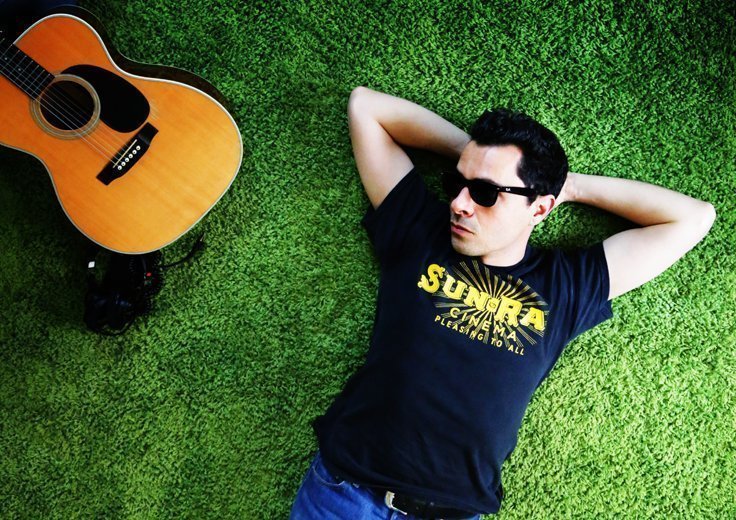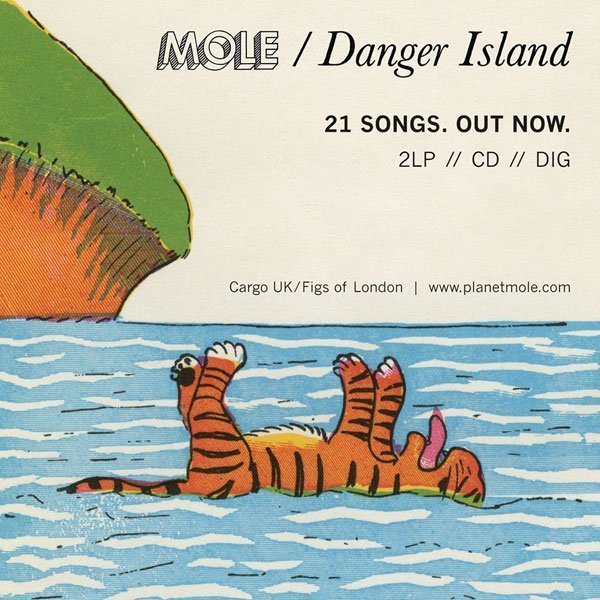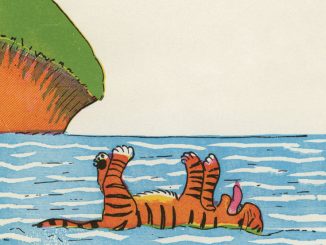
Danger Island is the debut solo album from singer-songwriter MOLE. An expansive double album of 21 tracks, it has been more than five years in the making. The album includes a stack of new songs, as well as a handful of older songs that never got a fair shake in the studio. Replete with rich, intricate string and brass arrangements, tuned percussion, and an array of beautifully understated guest performances, Danger Island is a kaleidoscopic jumble of experiments, fantasies and miniature symphonies. It is conceived as a proper, old-school double album, in the mould of The White Album, Tusk or London Calling – broad in scope and tone, colourful, ambitious, immersive.
MOLE is the solo project of Californian-born singer, songwriter and visual artist J. Maizlish Mole. For the last twenty years, he has been based in London, New York and Berlin, playing in dive bars, speakeasies, concert halls and every conceivable kind of venue with his various bands. He has been releasing solo work as MOLE since 2015’s Tar Baby EP. Mark Millar caught up with Mole to discuss the making of Danger Island and more.

You recently released your debut solo album Danger Island. Did you go into the recording with any preconceived ideas how it should sound and the kind of songs you wanted to write about?
Mole: Yes and no. I’ve always got some kind of sound or feel in mind when I’m writing, but if things go well, the track will take you somewhere unexpected in the recording and arranging. And with all the time we took, there were a lot of moments when a half-finished track would take a sudden turn in a new direction after laying fallow for a while. I’d be off working on some other part of the record, and come back to find that some poor thing I’d left out in the weeds all summer was suddenly blooming with new ideas. That’s how a relatively old song like Playing Possum, which sounded very bluegrassy when I wrote it, suddenly got a tabla thrown at it, and that Bron-yr-Aur kick through it. The longer we spent on the album, the broader its scope became. And because of this way of working, all 21 songs were still feeling fresh when we were finishing the album, even though some of their rhythm tracks were as many as five years old. The songwriting spans years and years, but, equally, I was still finishing up new material right up until the last few days of mixing, as the themes of the record came more and more into focus.
The album is quite expansive. Why did you decide to release a double album?
Mole: Well, it certainly snowballed, but it became clear pretty early on what it was going to be. It’s just an intuition. I knew it was going to be much stronger as a long rambling journey with everything under the sun thrown in. So, four arcs, two records, one big album. The double album is a really special form, I think. Since the 70-minute CD came along, and later the single-track download, it’s become an even more old-school art form than your basic two-sided single album. But I mean, look at Songs in the Key of Life, Zen Arcade, Blonde on Blonde, Tago Mago, Physical Graffiti, Soft Machine Third, Trout Mask Replica – it’s a perfect form in its own right, with different parameters and different things at stake. Or Fleetwood Mac’s Tusk, where they were like ‘Guys, I think this one might work best with a marching band. Recorded in a stadium.’ It isn’t just that there’s room for those kinds of digressions and experiments on a double album, it’s that the form kind of demands those things.
The White Album is the greatest example, in my opinion – you could look at maybe 2/3 of the tracks and think, well, the album would stand up fine without that one. But that isn’t the point. It’s a magnificent jumble. No two tracks are alike, many of them are inscrutable on their own, but each of the unlike fragments reflects the bigger picture from a different perspective. It’s one of my all-time favourites and was really the most important reference point for me when the album was taking shape. For my album though, I realise that it was possibly a slightly insane thing to have done – a big sprawling double for a debut solo album. No one would advise such a thing. Actually, many people told me not to. But fuck it, the songs wanted to run together over four sides, who am I to argue?
You began initial work on Danger Island in 2012 why did it take so long to complete the record?
Mole: Hard to say, really. When my old band folded up shop in 2011, I started rethinking plans for what would have been our third album – it was going to be called The Bee Sting, and I even had cover art in mind. But circumstances changed, and life intervened. I trashed most of the stuff from our initial 2012 sessions and started over with a punchier approach in 2014. Over time, some of the older songs got folded back in, like they just needed to be brought along. I worked on an incredibly thin shoestring for much of the time, in spite of having started out with a fair whack of money at the beginning, and a Kickstarter campaign in the middle. The finish line just kept getting further away as the album took shape. It’s one of the dangerous luxuries of running your own label, I guess – there are no deadlines or contracts, but it also means you can give the work all the time and attention it demands.
What is your songwriting process?
Mole: Every one of them’s different – some start with a melody or a phrase, or something that needs saying. Most of them pour out over a few days or a week. Lots of them then get refined and rethought over a year or two. Danger Island has a few songs which were written specifically to flesh out the album, to bookend a side or bridge a gap where something was felt to be missing. But mostly they form in isolation, each a world of its own until they start working their way into a set. Then they get treated like parts of a puzzle.
Did the songs come easily for the record?
Mole: There were too many to work with. I don’t rush the songs, but I also find the pressure of recording will often force them to shape up. They always come easily at first, but some of them will sit around 95% finished for ages and ages, waiting for a final stroke I just haven’t had the vision to see yet. The recording process forces that nicely.
Is there a particular song on the new album that you thought “this is why I’m doing this”?
Mole: They’re all like that at one time or another, every one of them. The more far out ones though, like Fireflies, The Grave Grass, or Blue Nova, they tended to really buzz from beginning to end.
Who produced the record?
Mole: I produced it myself. I’ve picked up a lot from some great producers over the years, though, and a lot of people contributed amazing things along the way. Ben Standage recorded a fair bit of it and mixed it beautifully, and his fingerprints are all over it. Brian O’Shaughnessy also recorded a bunch of the basic tracks early on, and it would never have gotten off the ground without him. And Dorian McFarland, he co-piloted the project from the beginning.
Was it an enjoyable experience recording the album?
Mole: Of course. Even the moments of despair are about pleasure, ultimately. When you’re looking at something and thinking – oh that is SHIT, what was I thinking? – you’re really just living for the relief of seeing that thing come back around, and into its own. I even pulled out the Oblique Strategies a few times, but crediting them on the sleeve looked wanky, so I left them off. They were actually invaluable. I work with amazing people too. They were always full of surprises and they all showed up with incredible belief in the project. Louis Vause, who played most of the piano and did most of the string arrangements – he breathed new life into everything he touched. Yes, it was joyful.
It’s wind down time after a show… what’s your go-to listen to unwind or recharge?
Mole: Winding down? Ann Peebles’ I Can’t Stand the Rain has been in regular rotation for years now for just that, as have Tim Buckley’s Starsailor, Joe Zawinul’s unbelievably beautiful Zawinul album, and early Ahmad Jamal. When I really need to clear my head though I’ll put on a playlist from a past road trip and drive down the roads again, track after track, feeling in love and elated or alone or whatever it was that was driving me then. I get all of it, the light and the air and the strangeness rolling by, from the tracks.
Will you be taking the album on the road?
Mole: You know, I haven’t had a regular tourable band for a few years now, but we’re putting one together now. It’s a relief to be rehearsing again. Should be playing out a lot through the first half of next year.
What are you most grateful for about being able to be a musician every day?
Mole: I was just listening to this old Sandy Denny song, ‘I’m sure you won’t believe me, but it is the truth to tell – that the living is hard, oh but it suits me well.’ Most of the artists I know live week to week, and lots of weeks are day to day. But when you get your rewards, you’re being rewarded for thinking about cadences or colours or something, for daydreaming, basically, or juggling ideas like they’re a bunch of cats. It’s all I ever really wanted. I don’t have to give a shit about much else, except taking care of my people and taking time out of my day to smash the patriarchy. I’m grateful for that.
Do you have a record that you always return to?
Mole: I have so many. Robert Wyatt’s Rock Bottom has never once lost its magic for me. Every time I go back to it, and I go back to it a lot, I’m right back down the rabbit hole like the first time I fell in. It’s Bowie’s Hunky Dory this week, though. Again, the spell just never wears off. It’s an entire world unto itself – I really don’t know how he did it or where it even came from.
What have you been listening to recently that you could recommend?
Mole: Both Directions At Once, the long-lost Coltrane Quartet album that just came out. Not sure I’ve ever been so excited about an archive release. Listening to the First Aid Kit album a lot, and Regina Spektor’s Begin to Hope. Also, Townes Van Zandt’s Flying Shoes album, because I’ve been thinking of more bare-bones sound for the next album. He does so damn much with so little.

Danger Island is out now in a deluxe double LP edition, in a gatefold sleeve with lyrics booklet and download card included, as well as a single CD edition in a six-panel digifile.
Deluxe 2LP Edition // Single CD // Digital
iTunes: https://apple.co/2MasKan
Juno: https://bit.ly/2BtTL3J
HMV: https://bit.ly/2MiZhLw
Spotify: https://spoti.fi/2nHG33l
Apple Music: https://apple.co/2Bi5tOr





Be the first to comment